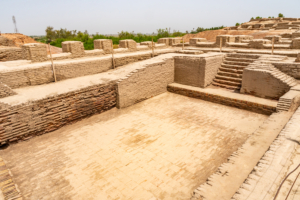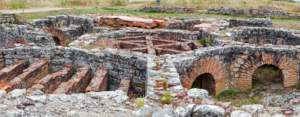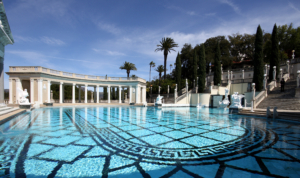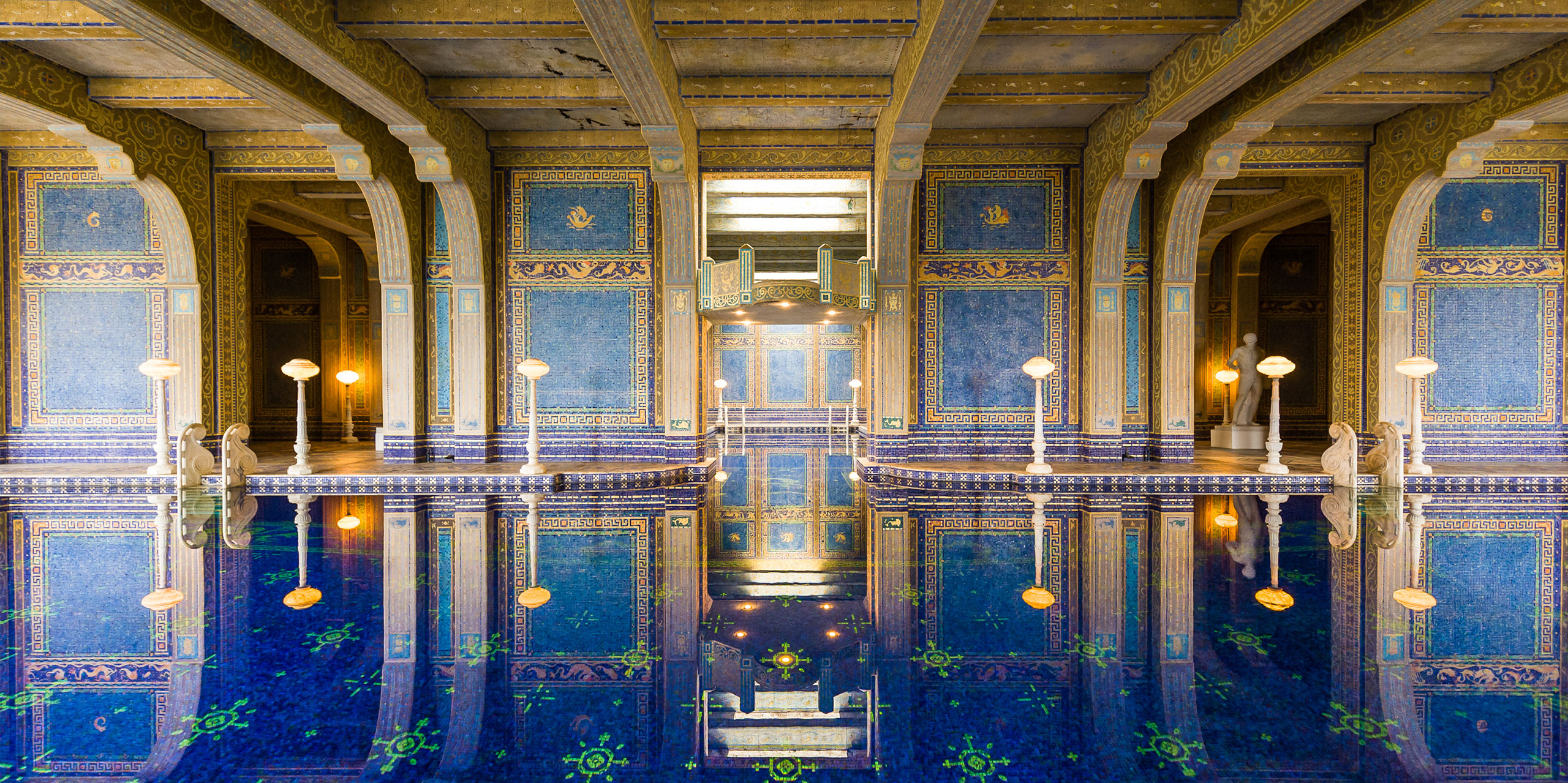Archaeologists place the first known swimming pool at Mohenjo-daro, a city that once inhabited the right bank of the Indus River, in southern Pakistan. This ancient city’s extensive network of archaeological ruins—designated as a UNESCO World Heritage site—includes a remarkably well-preserved bathing pool dubbed “The Great Bath.”
Dating back nearly 5,000 years ago, the Great Bath was probably built for ritualized bathing, possibly tied to Hindu and various other religious ceremonies. Intended or not, such frequent bathing raised the standard of hygiene in a population already known for prizing cleanliness and civic order.
The Great Bath is composed almost entirely of brick, its walls set eight feet lower than the surrounding pavement, which is presumably the world’s first known pool deck. Measuring approximately 40’ long by 23’ wide, the rectangular pool’s bottom consists of a double thickness of sawed brick set in a gypsum-based mortar, with a layer of bitumen (an ancient petroleum-based sealant) sandwiched between the two layers. Water was evidently supplied by a nearby well (or cistern), and an outlet in one corner of the bath functioned as the main drain.

The Great Bath
Meanwhile, a half continent away in Africa, hieroglyphics discovered at an archaeological site near Egypt’s southwest border with Libya depict scenes of people with arms outstretched as if in the act of swimming. These ancient drawings—which predate the Great Bath by 5,000 years—are situated inside Egypt’s Cave of Swimmers, so named because the drawings on its walls seem to underscore humanity’s abiding connection with water as well as the importance the ancient Mediterranean cultures placed on aquatic activities.
The Greeks, followed by the Romans, were among the first ancient civilizations to separate swimming from bathing. Both cultures considered swimming a necessary skill and often included swim lessons in the educational curriculum of elementary school age boys. Bathing for cleanliness or ritual was now reserved for smaller tubs and bathing pools tucked away inside the home.
The athletic-minded Greeks were famous for their palestrae, public gymnasiums used as sites to train young men in the art of wrestling and other athletic skills. A typical palestra featured a large interior courtyard—usually in the shape of a square or rectangle—which was open to the sky and surrounded by colonnades, covered hallways supported by columns. These colonnades linked the courtyard to dressing rooms, lecture rooms, bath, and equipment rooms. Athletes practiced beneath the colonnades in all kinds of weather and a more opulent palestra often featured a swimming pool in the courtyard.
At the height of their empire, prosperous Romans constructed opulent private bathhouses as potent symbols of their newfound wealth and elevated social status. As such, these pools were often adorned with intricate mosaics, graceful marble columns and ornate statuary, terraced decks, elegant fountains, and magnificent frescoes. Now used as much for socializing as for swimming, the Romans built separate pools for entertaining—distinct from their private pools for bathing—and spared no expense to make them as grand and glorious as possible.
The Romans were the first to use concrete to build swimming pools, their innovative blend of lime and pozzolana (a type of volcanic rock) creating a mortar not far removed from the material used today. However, the concrete-like materials used in today’s pools are usually reinforced with steel rods.
The Romans also pioneered heated pools. A wealthy Roman lord, Gaius Maecenas, is credited as being the first to use a hypocaust system to heat his pool. Giant fires were kept lit in a space under the pool. The hot air was then circulated through pipes imbedded in the walls and beneath the floor of the pool, which gradually warmed the water.

Hypocaust System
Fast forward to the 20th century and if you have ever visited California’s Hearst Castle then you have witnessed first-hand one of the most dramatic examples of how the classic Roman pools and palestrae of yesteryear have influenced modern pool design. The breathtaking hilltop estate, which overlooks the central California coastline from its perch above San Simeon, is often remembered most for its two iconic swimming pools.
The Neptune Pool, whose design unites the glamor and allure of Hollywood with the classic design sensibilities of the ancient world, is the estate’s spectacular outdoor swimming pool. Its sheer size and scope—it is 102 feet long by 52 feet wide and has an alcove measuring 95 feet in width—make it one of the prime focal points of the property. It has all the elements of a classic Greek palestra as only a business tycoon like Hearst could imagine one.

Hearst Castle : The Neptune Pool
For a more serene—almost mystical—swimming experience, the castle’s Roman Pool is modeled after ancient Roman baths, with royal blue and golden glass tiles forming intricate mosaics on the walls and ceiling beams. The Italian tiles, known as Smalti, are the result of molten glass that has been cooled, hand-cut into uneven half-inch squares and obviously used to hypnotic effect throughout the mansion’s dramatic indoor pool.
As the swimming pools of Hearst Castle make abundantly clear, the enduring principles of Greco-Roman architecture continue to resonate in contemporary pool construction, blending ancient architecture and time-honored design techniques with today’s newest building materials and cutting-edge technologies.


Comments